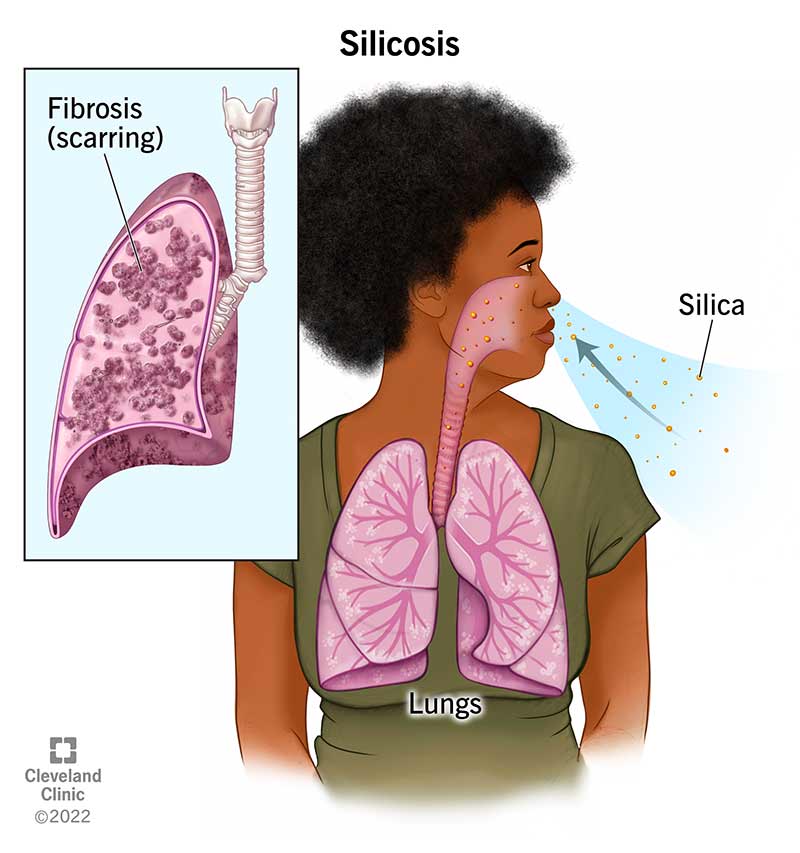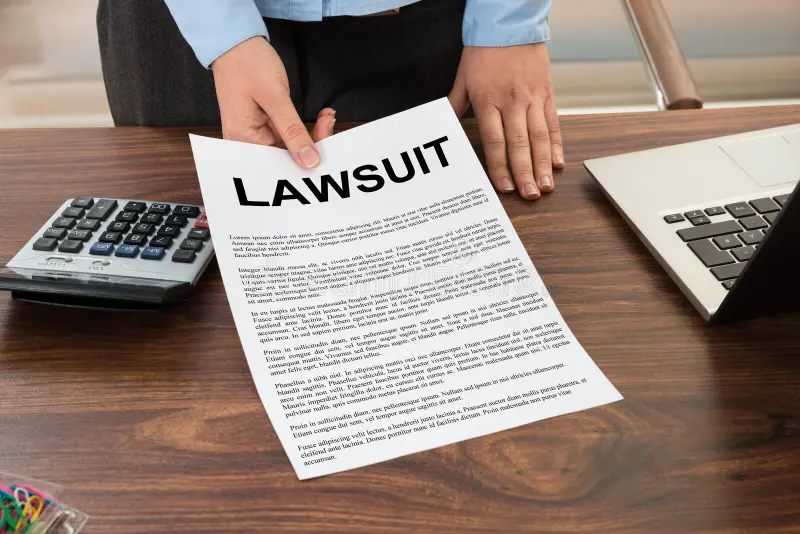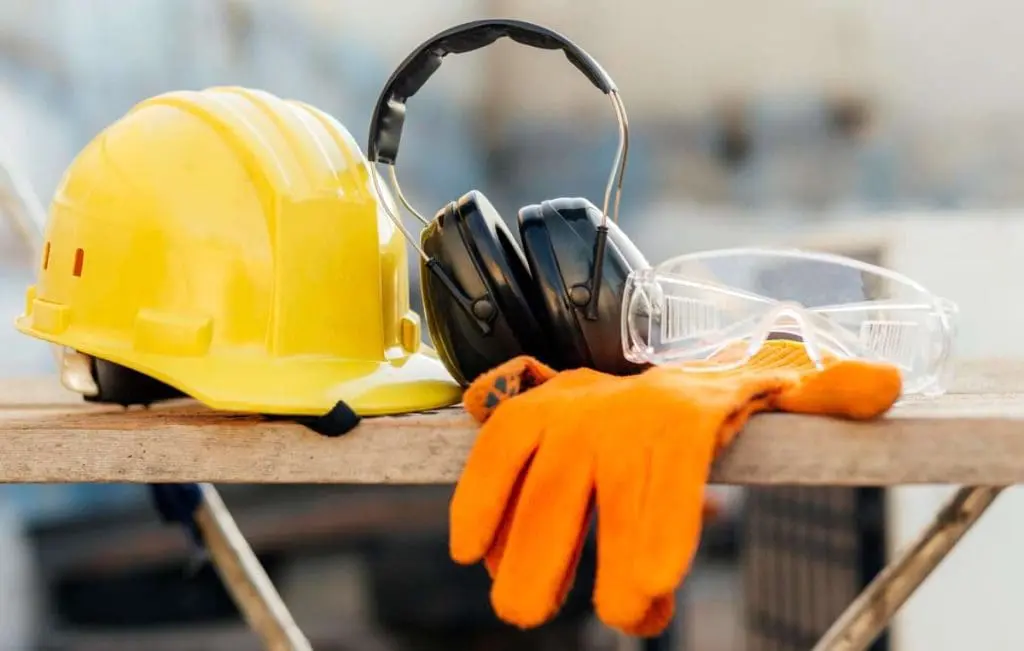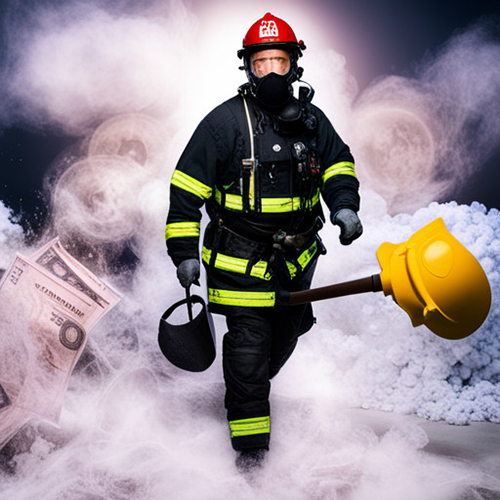File Your Silicosis Lawsuit Today!
CaseSettlement.com is dedicated to helping silicosis victims seek justice. If you’ve been diagnosed with a condition caused by silica exposure, our team is ready to connect you with experienced attorneys who specialize in silica litigation and who fight to secure maximum compensation for clients just like you.

What is Silicosis?
Silicosis is a type of pneumoconiosis—a progressive, irreversible lung disease caused by inhaling respirable crystalline silica (RCS). This microscopic mineral is found in materials like quartz, granite, sandstone, and engineered stone, and becomes airborne during processes like cutting, grinding, or polishing.
When inhaled, silica particles lodge deep into the lungs, triggering inflammation and scarring. This reduces lung capacity over time and can lead to oxygen deprivation, reduced quality of life, and in many cases, death.
There are multiple forms of silicosis:
- Chronic Silicosis: Occurs after long-term exposure (10+ years). The symptoms are slow to develop and include persistent cough and shortness of breath.
- Accelerated Silicosis: Can appear within 5–10 years of high-level exposure. Symptoms are similar to chronic silicosis but progress more rapidly.
- Acute Silicosis: Occurs after a few months to 2 years of very high exposure. Symptoms include severe inflammation, fluid buildup in the lungs, and life-threatening respiratory failure.
- Complicated Silicosis (Progressive Massive Fibrosis): In this advanced stage, large areas of the lungs are damaged. Breathing becomes difficult, infections are common, and lung function is drastically reduced.
Many patients require oxygen, steroidal treatments, or even double-lung transplants. Unfortunately, silicosis remains incurable and frequently leads to death if untreated or diagnosed late.
Symptoms and Diagnosis of Silicosis
Symptoms of silicosis often begin subtly and worsen over time. Early diagnosis is critical but challenging, as many symptoms resemble other respiratory conditions.
Common symptoms include:
- Shortness of breath, especially during physical activity
- Persistent dry cough
- Chest tightness or pain
Fatigue and general weakness
Loss of appetite and unintended weight loss
Cyanosis (bluish discoloration of lips/fingers)
Frequent respiratory infections
As the disease progresses, symptoms may become debilitating. Patients in advanced stages often require daily oxygen supplementation and suffer from reduced mobility.
Diagnosis typically involves:
- Chest X-rays or high-resolution CT scans to detect lung scarring
- Pulmonary function tests (PFTs) to evaluate breathing capacity
- Blood tests to rule out other conditions
- Occupational history review, especially in industries like stone fabrication, mining, construction, or foundries
Doctors may also conduct bronchoscopy or lung biopsy in uncertain cases. Unfortunately, many diagnoses happen only after significant damage has occurred.


How Silicosis is Treated
There is no cure for silicosis. Treatment focuses on managing symptoms, slowing progression, and improving quality of life.
Standard treatment options include:
- Bronchodilators: Help open airways and ease breathing
- Inhaled corticosteroids: Reduce lung inflammation
- Pulmonary rehabilitation: Supervised exercise and breathing training
- Oxygen therapy: For patients with low blood oxygen levels
- Antibiotics and vaccinations: To prevent or treat infections
- Lung transplantation: Considered in end-stage disease when other treatments fail
Doctors also advise strict avoidance of further silica exposure. In some cases, workers must leave their jobs to prevent worsening of the disease.
Legal Rights for Silicosis Victims
If you were exposed to silica dust in the workplace and later diagnosed with silicosis, you may be entitled to file a lawsuit against:
- Your employer, if they failed to implement proper safety measures
- Equipment manufacturers, if their tools lacked necessary dust controls
- Engineered stone suppliers, if they ignored known health risks
You have the legal right to seek compensation for:
- Medical expenses (past and future)
- Lost wages and reduced earning capacity
- Pain and suffering
- Disability and diminished quality of life
- Funeral expenses (in wrongful death cases)
Attorneys experienced in silica exposure cases know how to navigate the complex medical, regulatory, and occupational factors involved. They gather workplace safety records, expert medical testimony, and compliance documents to build a compelling case.

FILL OUT THE FORM TO GET YOUR FREE CLAIM REVIEW

Real Case Examples and Settlements
Lawsuits involving silicosis have resulted in substantial compensation for victims and their families. Here are several notable cases:
Example 1: California Engineered Stone Fabricator
A 43-year-old worker diagnosed with progressive massive fibrosis (PMF) after a decade working with engineered quartz settled for $5.2 million. The employer was found to have inadequate dust controls and failed to provide proper respiratory protection.
Example 2: Texas Foundry Worker
A former sandblaster developed acute silicosis and died at age 38. His family was awarded $7.5 million in a wrongful death settlement. Documentation showed multiple OSHA violations over several years.
Example 3: Multi-State Class Action Against Stone Suppliers
Over 100 plaintiffs in multiple states joined a class action against large engineered stone companies. Allegations included failure to warn, insufficient safety documentation, and defective labeling. Total settlement exceeded $52 million.
These real-world examples illustrate the legal system’s recognition of the severe harm caused by silica exposure and the potential for meaningful compensation.
How Employers Negligently Expose Workers
Despite clear OSHA guidelines, many employers cut corners to save costs. Common forms of employer negligence include:
- Failing to provide or enforce the use of NIOSH-approved respirators
- Using dry cutting methods instead of wet cutting
- Inadequate ventilation in indoor workspaces
- No regular training on silica hazards
- Lack of dust suppression systems or HEPA vacuums
- Skipping mandated medical exams and exposure monitoring
Negligent employers are often held liable in court, especially if they knowingly exposed workers to unsafe environments. Even if a company followed basic regulations, it may still be liable if its conduct contributed to your illness.
Statute of Limitations: Don’t Miss the Deadline
Each state has its own statute of limitations for filing a personal injury or wrongful death lawsuit. This time limit typically ranges from 1 to 4 years from the date of diagnosis or discovery of the illness.
Examples:
- California: 2 years from diagnosis
- Texas: 2 years
- New York: 3 years
- Florida: 4 years
- Illinois: 2 years
If you miss this deadline, your right to compensation may be permanently barred. That’s why speaking with a silica attorney as soon as possible is essential.


How U.S. Safety Standards Compare Globally
The U.S. is not alone in confronting the risks of silica dust, but other countries often take stricter measures to protect workers:
- Australia: Certain states have banned dry cutting of engineered stone entirely. Workers must undergo mandatory health checks every two years.
- United Kingdom: Employers must keep detailed exposure logs and provide respiratory protective equipment. Air quality must be monitored continuously.
Canada: Uses a national surveillance system to track occupational diseases and enforce provincial air quality standards.
In the U.S., OSHA’s permissible exposure limit (PEL) is 50 µg/m³, but enforcement is inconsistent—especially in non-union worksites or small businesses. Legal action plays a crucial role in holding employers accountable where regulations fall short.
Step-by-Step Legal Process for Filing a Silicosis Lawsuit
Filing a lawsuit may seem daunting, but the legal process is designed to help victims secure justice and compensation without overwhelming them. Here’s what to expect when you work with a silica attorney:
- Free Consultation: Speak with a legal professional about your diagnosis, work history, and symptoms.
- Eligibility Screening: Your attorney will assess your case and determine if it meets legal requirements.
- Document Collection: Medical records, employment files, safety reports, and exposure history are gathered.
- Filing the Lawsuit: A complaint is filed against the negligent party or manufacturer.
- Negotiations and Discovery: Both sides exchange evidence. Your lawyer may attempt to negotiate a settlement.
- Deposition/Testimony: You may provide sworn testimony. Your lawyer will prepare you thoroughly.
- Resolution: The case settles out of court or proceeds to trial. If successful, you receive compensation for damages.

Frequently Asked Questions (FAQs)
1. What is silicosis and how is it caused?
Silicosis is a lung disease caused by inhaling silica dust. It causes scarring in the lungs and leads to breathing difficulties.
2. Do I qualify for a silicosis lawsuit?
If you’ve worked in construction, mining, sandblasting, or stone cutting and have been diagnosed with silicosis, you may qualify.
3. How much does it cost to hire an attorney?
Most silica attorneys work on a contingency fee basis, meaning they only get paid if you win.
4. What is the average settlement amount?
It varies by case. Some settlements reach millions of dollars, depending on severity and negligence.
5. Will I have to go to court?
Not always. Many cases settle out of court. If a trial is necessary, your attorney will represent you.
6. Is there a time limit to file?
Yes, statutes of limitation apply. Typically 1 to 4 years from diagnosis, depending on the state.
7. Can undocumented workers sue?
Yes. Legal status does not affect your right to seek compensation for workplace-related illness.
8. How long do these cases take?
Some resolve in a few months, while others may take over a year, especially if they go to trial.
9. What if my employer went out of business?
You can still pursue claims against manufacturers, insurers, or successor companies.
10. Can family members sue for wrongful death?
Yes. Spouses and dependents may file a wrongful death claim if a loved one died from silicosis.
Take the First Step Toward Justice
If you or a loved one has been diagnosed with silicosis, don’t wait. Every day matters when it comes to preserving your legal rights.
Start by filling out our quick online case review form. It’s 100% confidential, free, and places you under no obligation.
CaseSettlement.com connects you with experienced silica attorneys who fight to win.
✔ Free Legal Case Review
✔ No Fees Unless You Win
✔ Millions Recovered for Silicosis Victims
✔ Nationwide Legal Support
Your voice matters. Your case matters. Let us help you claim the justice and compensation you deserve.
Our Services
AFFF Lawsuit
Support
We help firefighters and military personnel file lawsuits for health issues caused by exposure to AFFF. Our team will guide you through every step of the legal process.
Motor Vehicle Accident Claims
If you’ve been injured in a motor vehicle accident, we’ll handle your claim, negotiating with insurers to ensure.
NEC Lawsuit
Assistance
Parents of infants diagnosed with Necrotizing Enterocolitis (NEC) can seek compensation from negligent formula manufacturers.
RoundUp Lawsuit Assistance
Individuals diagnosed with health issues, including cancer, due to exposure to RoundUp may be
Product Liability Help
We help you secure compensation for injuries caused by harmful products and accidents.
Innovation
We embrace cutting-edge legal strategies and technologies to stay ahead in delivering the best outcomes for our clients. Our innovative approach ensures we tackle challenges effectively and efficiently.
Excellence
Our pursuit of excellence means every case is handled with the utmost care and precision. We are dedicated to upholding the highest standards in legal representation and client service.
Results
We are focused on achieving tangible results for our clients, striving to secure the compensation and justice they deserve. Our track record reflects our commitment to successful case outcomes.
Collaboration
We believe in the power of collaboration, working closely with clients, experts, and partners to build strong, effective cases. This teamwork enhances our ability to address complex legal issues and achieve favorable results.



